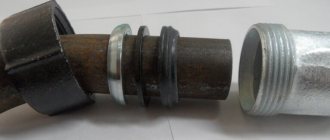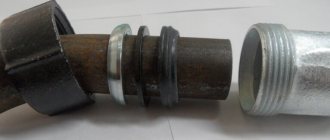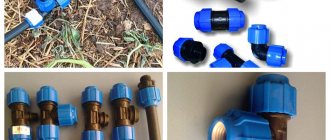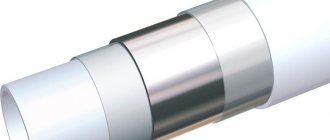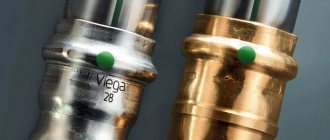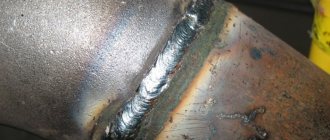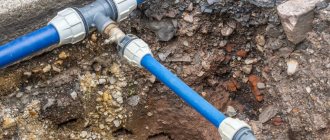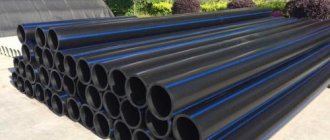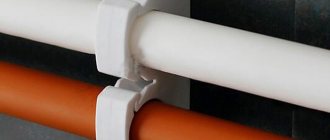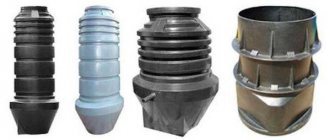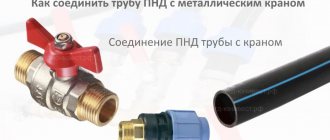The services of repair teams or simply specialists who can perform technological operations often cost a lot. Therefore, the natural desire of many of our fellow citizens is the desire to save money by maintaining their family or personal budget. Sometimes this requires solving various problems. For example, connecting asbestos pipes. Let's consider how this procedure can be carried out, what its features are, and whether it is possible to connect products of different diameters and materials. For this we will use photo and video materials.
Requirements for connections between asbestos-cement pipes
Like any other erected structure, a number of technological, engineering and other conditions are imposed on connections of asbestos-cement pipes, the main of which are the following:
- Simplicity of the docking method. This requirement is due to the fact that asbestos-cement pipes, as a rule, are heavy products, the installation of which is already difficult. Therefore, the simplified joining process can somewhat compensate for the complexity of the assembly as a whole.
- Tightness and strength of the connection. This condition is common for pipelines of any type, and asbestos-cement pipes are no exception in this regard.
- The location of the connected tubular products is strictly along one longitudinal axis. Since asbestos cement is a relatively fragile material, uniaxial placement of pipes during installation plays a very important role, preventing fragility of the structure as a whole. In some types of connections between such pipes, minimal deviations from the axis are allowed, but very insignificant.
- Chemical passivity of materials intended for transportation through pipelines in relation to asbestos cement. This is an important condition, otherwise after some time a change in the physical and chemical properties of the structure occurs, and then its failure.
- Stability of butt zones and connection elements with respect to operating pressure, temperature and other conditions in which the pipeline is expected to operate.
The very quality and reliability of the design largely depend on how strong and technically competent the connections between the pipes are. If we talk specifically about methods of connecting asbestos-cement pipes, then there are several of them.
Features of installing a section of plastic sewerage into a cast iron system
To insert a plastic section into the working system, a sewer adapter and a compensator are used, due to which installation becomes possible without disassembling the entire structure.
Installation is carried out as follows:
- an adapter is inserted into the socket that has been cleaned and treated with sealant;
- there is a plastic compensator in it;
- into the compensator until it stops - a plastic pipe;
- the structure is connected from the other end, gradually releasing the pipe from the compensator.
Whatever sewerage design is proposed, whatever materials are to be used, work should begin with drawing up a plan with a clear outline of all the necessary connections.
If you plan to independently repair or install a sewer system, it is important to study the features of the upcoming work and consult with specialists in terms of purchasing the necessary materials. The existing offer of pipes, adapters and fittings allows us to install even the most complex systems.
Types of connections when installing asbestos-cement pipelines
All types of connections between asbestos-cement pipes are divided into socket and coupling.
Socket connections are used quite rarely and only in cases where the pipeline being installed is not intended for operation under high pressure. Sealing such connections is difficult due to the large weight and noticeable fragility of the pipes, and this prevents the assembly of pipeline structures with high reliability.
Coupling connections of asbestos-cement pipes are the most popular, and in turn have several varieties:
- through a double-breasted asbestos-cement coupling and rubber ring;
- through a non-pressure asbestos-cement coupling;
- through a cast iron flange coupling “Zhibo”;
- through a polyethylene coupling MPT.
As can be seen from the names of the mentioned methods, there are various options for coupling devices for connecting asbestos-cement pipes into a single pipeline system. These types of coupling products cover not only the possibilities of how to connect an asbestos pipe to an asbestos pipe, but also methods of joining with products made from other materials. Installation using each of these couplings has its own characteristics and areas of application, which should be discussed separately.
Characteristics
All pipe products made from asbestos cement must undergo a series of tests described in GOST 11310-90. To allow a product to be put into operation, it must meet several parameters:
- water tightness test by filling the pipe cavity under a specified pressure. Non-pressure products must withstand flow for 10 seconds, pressure - 30 seconds;
- bending strength and tensile strength are also checked in a water-filled state. The pipe is placed under a press, the pressure of which is brought to a given value. Within 10 seconds, the walls should not show any signs of destruction.
The pressure value for asbestos-cement pipes with different diameters and wall thicknesses is determined individually. Based on test results, products are divided into 4 classes:
| Class designation | Operating pressure | ||
| pipes | couplings | MPa | kgf/cm2 |
| VT6 | CAM6 | 0,6 | 6 |
| VT9 | CAM9 | 0,9 | 9 |
| VT12 | SAM12 | 1,2 | 12 |
| VT15 | SAM15 | 1,5 | 15 |
As you know, for normal combustion of fuel a supply of oxygen is necessary. Oxygen is supplied along with outside air. Oxygen is supplied along with outside air. Air is supplied by draft. But what affects the quality of traction?
Connection using a non-pressure asbestos cement coupling
This type of connection is usually used when assembling an asbestos-cement pipeline intended for non-pressure lines, if the pipe products have different diameters.
Two identical holes with diameters of 15-20 millimeters are drilled in the coupling, located along the same center line. Before starting assembly, the required location of the coupling after installation is marked at the end sections of the pipes being joined.
First, one of the pipes is laid, and a non-pressure coupling is put on it. Next, lay the second pipe, bringing it closer to the first pipe with the coupling at a distance of 3-5 millimeters. The ends of the articulated pipes are centered, placing the products along one longitudinal axis. The joint areas are wrapped with wide bitumen tape for subsequent sealing.
Next, the coupling moves to the junction of the pipe products and is also put on the second pipe - up to the previously made mark. The drilled holes should be located at the top. The gap between the walls of the coupling from the inside and the walls of the pipes from the outside is filled with tow for a third of the length from the pipe end to the edge of the coupling.
Next, hot bitumen resin or mastic is poured into one of the holes drilled in the coupling, continuing until the sealant, having completely filled the space between the pipe and the coupling, begins to pour out of the other hole. After this, the structure should be left completely motionless until the bitumen has completely hardened.
Purpose of adapters
Modern sewer lines are in the vast majority of cases installed from polymer pipes. Depending on the layout, the sewerage system has a distribution throughout the building, which is connected to a common drain and discharged outside.
The pipeline configuration has many straight sections that are interconnected into complex systems with turns, bends, tees, crosses, plugs and revisions.
When assembling the pipeline, sewer adapters made of polymer materials are used. They can be either removable or soldered.
Old buildings are equipped with sewer pipelines made of cast iron, less often made of steel. To repair, partially replace or insert a separate apartment with a plastic sewer system, it is necessary to combine pipes made of metal alloys with pipes or fittings made of polymer materials into one system.
Here adapters also come to the rescue, which are made with special different ends and allow you to reliably connect dissimilar communications. Plumbing sewer adapters are designed for:
- connections of straight sections of pipeline with different diameters;
- connecting pipeline sections made of different materials (the diameter can be either the same or different from each other);
- creating the necessary configuration of the sewer section (turns, bypass, routing).
Note! Before purchasing sewer adapters, you should know not only the required material and diameter, but also the type of thread - external or internal.
Connecting asbestos pipes using a cast iron coupling “Zhibo”
“Zhibo” (or “Jabot”) couplings, made of gray cast iron, are rather complex devices consisting of two flanges, tightening bolts, a mounting sleeve and two rubber sealing rings.
This type of coupling for connecting asbestos-cement pipes does not require high precision processing of their end sections, which is a significant advantage. This advantage is especially noticeable in situations where it is necessary to cut an asbestos pipe into separate sections for installation or repair purposes.
The connection of asbestos-cement pipes using Zhibo couplings is carried out as follows:
- The pipes are laid at the bottom of a trench dug for this purpose.
- One of the flanges, a mounting sleeve and one of the rubber sealing rings are put on the end section of the first pipe.
- In a similar way, another flange and a rubber O-ring are put on the second pipe.
- The pipes are centered, positioning them along the same axis.
- The flanges are tightened and secured using bolts.
The advantages of this method were mentioned above, but if we talk about its disadvantages, the most significant of them is the susceptibility of tie bolts to the corrosion process, which can in the future lead to their destruction with a violation of the integrity of the structure.
Dimensions of sewer adapters
Manufacturers of plumbing fittings offer a large selection of plastic sewer adapters of different diameters and modifications. In civil engineering, for individual wiring, pipes, adapters and fittings with a diameter of 50 mm and 110 mm are most applicable. To drain kitchen waste, pipes of a smaller diameter are used, and for sewer drains, a larger diameter is used.
Note! The connection of pipes of different diameters is carried out according to the rule “increase in size along the drain”. Switching to a smaller diameter along the drain leads to rapid clogging and depressurization of the sewer system.
Commonly used sewer adapters:
- transition from 50 to 110 mm in the form of a coupling;
- transition with a change in direction - corners;
- connection of more than 2 pipes with different diameters (from 50 to 110 mm; from 25/20 to 50 mm) - tees, crosses;
- bypasses - special curved fittings for bypassing pipes without additional joints;
- compensators - for removing hot waste from a plastic pipeline.
For forced drainage, when the sewer system is operated under pressure, either steel pipelines or plastic ones made of polyvinyl chloride are used.
Sewer adapters are selected according to the pipe materials. PVC pipelines are operated at pressures from 6 to 12.5 atmospheres. This requirement remains true even if forced circulation is carried out periodically.
Connection via polyethylene MPT coupling
This is another common way to connect asbestos pipes to each other. This method is most often used for joining free-flow asbestos-cement pipes with diameters of 100-300 millimeters, used for laying communication cables.
The MPT coupling itself is a product made of high-density polyethylene (HDPE), having a ring-shaped shape with a ribbed inner surface. Before pulling it onto the joint, this polymer device is heated in hot water (10-20 minutes at a temperature of about 100 °C). After this, the hot coupling is put on one side on the first of the two pipes being connected, and the opposite side on the other. The pipes are inserted into the coupling to the maximum, when they rest against the internal side-partition contained in it.
Sometimes there are situations when it is not possible to put an MPT coupling on pipes. In these cases, they resort to connection using metal cuffs, under which a brizol, metalloizol or hydroisol lining is placed. Pliers are used as a tool for such installation. They tighten the cuff, after which the joint zones of asbestos-cement products are filled with cement mortar.
The thickness of the layer of such filling should be at least 10-15 millimeters. One of the advantages of using metal collars is that the end sections of the joined pipes do not require careful processing.
What is more profitable to do yourself or order?
And here a dilemma creeps in: on the one hand, a solid fuel (SF) boiler is very similar to a conventional stove.
And we’ll be able to make a chimney for it. This is exactly what many boiler owners think. However, it would be a mistake to think that this matter will be simple: competent calculations, thoughtful design and high-quality installation are important here, because the lives and health of all members of your family depend on this. Errors in design, loose joints - all this can lead to carbon monoxide entering the room. And this is already very dangerous!
Therefore, if you do not have professional stove-maker skills, then it is better not to take on the job. And if you are confident in your abilities, or the design of the chimney is not very complicated, then feel free to get down to business.
It is better to order chimney calculations from a construction company, where they will do everything right for you!
Pros and cons of structures made from asbestos cement pipes
In general, both the asbestos cement pipes themselves and the structures made from them have a number of important technological advantages, such as resistance to corrosion and freezing, fire safety, minimal expansion under high temperatures, electrical insulating properties, low cost along with a wide range of sizes. It is these properties that determine their demand in a number of industrial, economic and other areas.
As for the disadvantages, two main ones can be identified: the large weight of asbestos-cement products and poor resistance to impact loads that can cause damage. These factors should be taken into account when installing and laying pipelines, as well as subsequently during their operation. If operating conditions are properly observed, the service life of asbestos-cement pipelines is quite high and can be 30-40 years or more.
Scope of application
Asbestos-cement pipes are used in various fields of construction. For example, they are used in the construction of sewage drains, both pressure and non-pressure. They often serve to supply water, both drinking and technical. Such pipes can also be used in the construction of a hot water supply system.
In addition, asbestos-cement pipes are used in agriculture. There they are necessary when installing a reclamation system and drainage structures. In private houses, they are used to build wells, using them as casing pipes.
In apartment buildings, there is another area of application for asbestos-cement pipes, in addition to water supply and sewage collection. These are garbage chute pipes. They are designed for both solid and liquid waste.
Due to the fire resistance of both asbestos itself and the structures that include it, such pipes are used for the construction of chimneys. However, there are several limitations in this application. In general, asbestos cement is used wherever there is a need for waterproofing, heat resistance, wear resistance and durability.
Chrysotile cement and ceramic products
Chrysotile cement pipelines are a type of asbestos products. Their production began quite recently. The difference between the two types of materials is that chrysotile is as safe as possible for health and the environment.
Asbestos cement coupling is used to connect ceramic pipelines
It is classified as a carcinogen, since after entering the body it remains in it for a long time, as it is eliminated from it extremely slowly.
Installation of the pipeline between each other involves cutting the line. Cutting leads to the formation of a saw, which makes the product harmful. When working with the material, it is strongly recommended to use a respirator.
It is precisely because of the pathogenicity of the effect of amphibole on the body that chrysotopes are used today. The way the pipe is marked indicates that chrysotile cement products have greater strength. For example, BNT-100 is suitable for systems with a light load, and BNT 150 is versatile and can be used in any system.
Do-it-yourself brick chimney for a solid fuel boiler
The construction of the pipe itself is not difficult, especially for those who have already had experience working with similar material
However, during construction it is important to take into account some features that will allow you to create a reliable and durable structure. It will most effectively cope with the effects of condensation and precipitation
Important: A brick chimney for a boiler can only be installed during the construction of a house, since such a pipe will have considerable weight and will require a solid foundation. The height of the foundation should be at least 30 cm, and the width should be selected based on the width of the structure itself: the foundation should exceed it by 15-50 cm on each side
The height of the foundation should be at least 30 cm, and the width should be selected based on the width of the structure itself: the foundation should exceed it by 15-50 cm on each side.
If the boiler chimney becomes part of an external wall, the foundation must also extend and be the lowest level of the wall foundation.
- For laying it is necessary to use refractory brick M75 or M50. To fix them, cement mortar or a mixture of cement and lime is suitable. A high-quality chimney can be obtained by performing masonry with bandaging: ensuring that the seams of the previous row overlap the next one.
- During construction, it is necessary to treat the inner surface and rid it of roughness.
- It is better to finish the upper part of the chimney for the boiler with a head protruding 10 cm beyond the brick base.
Ventilation holes can be added under the head to prevent air from blowing in. They must be placed on two opposite walls or on each side.
Compliance with these principles will allow you to create a chimney for a solid fuel boiler yourself, be it a straight pipe through the roof or going into the wall. Each design method has its advantages:
- A chimney passing through an attic or roof will transfer heat to all rooms through which it passes, therefore it is suitable for two or more storey buildings. In addition, it is easy to construct.
- A chimney passing through a wall is compact and safer than a conventional one.
Tip: You can add a metal pipe to the inside of a brick chimney for a boiler, which will protect the walls from soot.
Thus, brick chimneys for boilers are the most optimal when comparing the complexity, cost and reliability of construction. Therefore, having studied all the necessary information, you can purchase materials and begin building a chimney with your own hands.
